Understanding Autism Spectrum Disorder (ASD) is more important than ever in today’s world. But what exactly is autism spectrum disorder, and why is it called ASD? Let’s start with the basics: the ASD full form is Autism Spectrum Disorder, which is a developmental condition that impacts a person’s communication skill, interacts, and experiences the world around them.
The simple answer to what is autism spectrum disorder lies in its name — it’s a spectrum. This means every person with ASD is unique. Some may need significant support in daily life, while others may live independently. The autism spectrum disorder meaning goes beyond just a medical term — it represents a diverse range of strengths and challenges. In other words, the asd meaning is not about a disease that needs to be “cured” but about embracing a different way of seeing and processing the world.
Globally, around 1 in 100 children is diagnosed with autism spectrum disorder, according to the World Health Organization (WHO). In India, awareness of ASD is growing, but many families still struggle to access early diagnosis and support. Knowing the autism spectrum disorder definition helps families, schools, and communities provide better understanding, acceptance, and the right interventions.
So, what is ASD really about? It’s about recognizing that neurodiversity is a part of humanity. By learning the real ASD definition, we can build a more inclusive world where every individual on the spectrum has the opportunity to thrive.
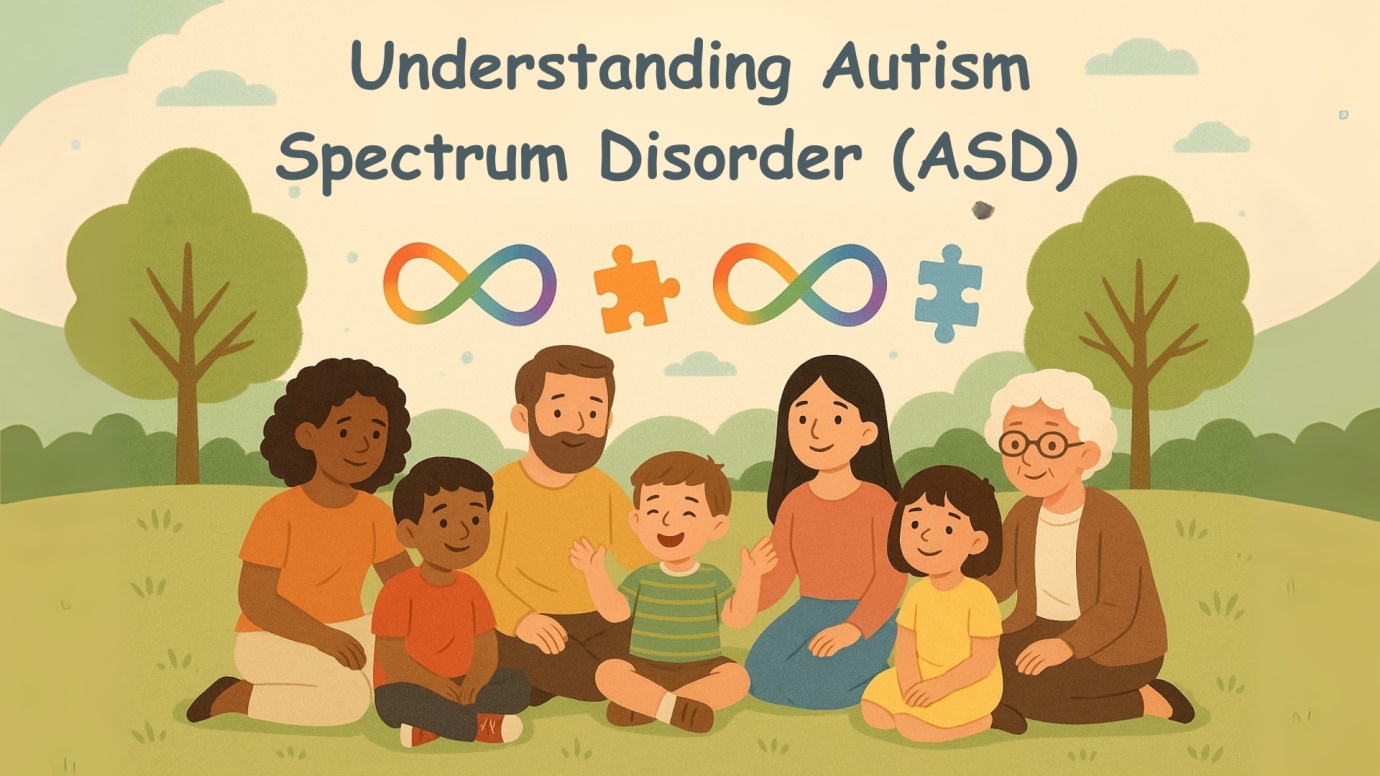
What is Autism Spectrum Disorder (ASD)?
When people first hear the term ASD, they often ask: What is ASD, really? In simple terms, Autism Spectrum Disorder is a neurodevelopmental condition that affects how a person thinks, communicates, interacts with others, and experiences the world.
The autism spectrum disorder definition is officially described in medical references such as the Autism Spectrum Disorder ICD 10 classification system, which healthcare professionals use to code and diagnose medical conditions. In modern psychology, the autism spectrum disorder DSM 5 — the fifth edition of the Diagnostic and Statistical Manual of Mental Disorders — outlines clear criteria for recognizing and diagnosing ASD.
But what makes Autism Spectrum Disorder different from other conditions? It’s the “spectrum” part that truly defines it. Here’s why it’s called a spectrum:
Wide Range of Experiences:
Every individual with ASD is unique. Some may have significant support needs, while others may live independently with minimal support.
Diverse Strengths and Challenges:
One person with Autism Spectrum Disorder might be nonverbal, while another might have excellent verbal skills but struggle with social cues.
Combination of Traits:
Many traits overlap with what used to be separate diagnoses, like autism spectrum disorder pervasive developmental disorder (PDD). Now, these fall under one umbrella — ASD — to better capture the whole range of abilities and differences.
From the neurodiversity perspective, Autism Spectrum Disorder is not seen as a flaw or disease to be “cured” but as a natural variation in how human brains work. This mindset reminds us that people with ASD contribute unique perspectives, talents, and ideas to society — whether that’s in art, technology, music, or everyday life.
So, when you hear what is ASD, remember that it’s more than a medical term like autism spectrum disorder ICD 10 or DSM 5. It’s an invitation to celebrate differences, accept neurodiversity, and support each person’s journey to live life to their fullest potential.
Signs & Symptoms of ASD
Recognizing the signs & symptoms ASD is an important step for early support and understanding. While every individual on the spectrum is unique, certain autism spectrum disorder symptoms are commonly observed across ages and situations.
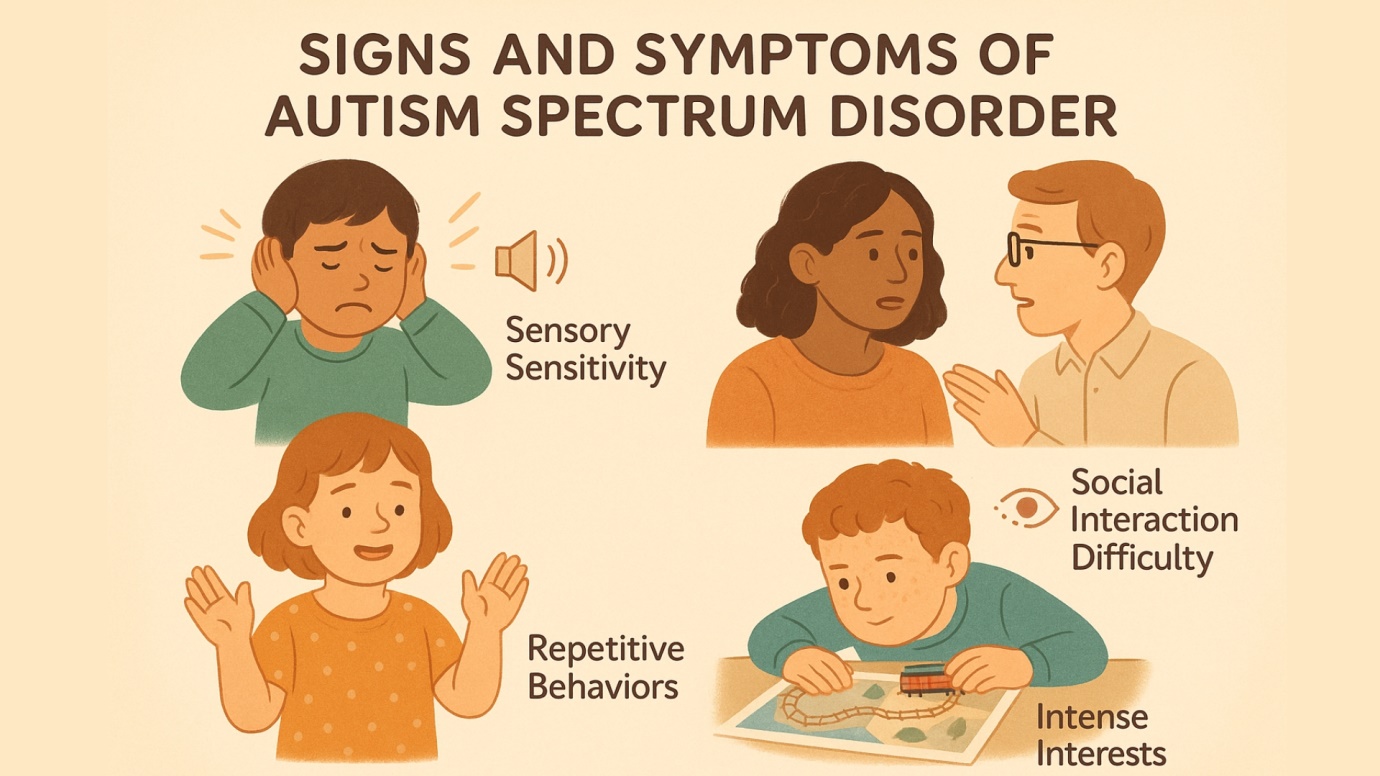
In simple words, the characteristics of Autism Spectrum Disorder —can be grouped into a few key areas:
Social Communication and Interaction Difficulties
One of the core clinical features of autism spectrum disorder is how it affects social interactions. People with ASD may experience:
- Difficulty maintaining back-and-forth conversations.
- Challenges understanding or using nonverbal cues like eye contact, facial expressions, and gestures.
- Trouble developing friendships or knowing how to engage in group activities.
- Limited interest in sharing emotions or experiences with others.
These ASD symptoms can show up differently in children and adults.
Restricted or Repetitive Behaviors
Another common set of autism spectrum disorder symptoms involves behaviors that feel repetitive or unusually focused. These can include:
- Repeating movements like hand-flapping, rocking, or spinning (known as stimming).
- Strict adherence to routines or rituals, getting upset when things change.
- Intense, highly specific interests — like memorizing maps, train schedules, or statistics.
- Repeating words or phrases (echolalia).
Such patterns are among the defining characteristics of ASD, and they can sometimes bring comfort or help an individual self-regulate their emotions.
Sensory Sensitivities
Many people with Autism Spectrum Disorder have unusual responses to sensory input. This is one of the important clinical features of autism spectrum disorder to watch for:
- Overreacting to sounds, lights, textures, or smells.
- Avoiding certain foods because of taste or texture.
- Seeking sensory input through activities like spinning, touching surfaces, or watching moving objects.
These symptoms often explain behaviors that might seem odd but serve a purpose for the person experiencing sensory overload or under-stimulation.
Early Signs Parents Might Notice
Identifying early autism spectrum disorder symptoms can help families get the right support. Some signs may appear before the age of two, such as:
- Limited or no babbling by 12 months.
- Lack of pointing or showing objects to others.
- No single words by 16 months or two-word phrases by 24 months.
- Loss of verbal abilities that were previously acquired or social skills.
Remember, the characteristics of autism spectrum disorder evolve with age. It’s possible for autism spectrum disorder symptoms in adults to look different from those in children, often appearing as social withdrawal, anxiety in social situations, or extreme focus on specific hobbies.
No two people experience ASD symptoms in the same way. Understanding the characteristics of ASD helps families, educators, and communities respond with empathy and support, making everyday life more inclusive for everyone living with Autism Spectrum Disorder.
Causes and Risk Factors of ASD
When families first hear a diagnosis of ASD, one of the first questions they ask is: “Why did this happen?” Understanding causes of autism spectrum disorder is a crucial step in clearing up myths and focusing on what truly matters — early support and acceptance.
The truth is, science shows that autism spectrum disorder causes and symptoms come from a complex mix of factors. While there’s still a lot to learn, research points to both genetic and environmental influences, with no single cause that fits everyone.

Genetics
Genetics play a major role in the causes of autism spectrum disorder. Studies show that:
- Certain gene changes or mutations can increase the likelihood of developing ASD.
- If one child in a family has Autism Spectrum Disorder, there is a higher chance that a sibling may also be diagnosed.
- Some rare genetic conditions, such as Fragile X Syndrome or Rett Syndrome, are strongly linked to autism spectrum disorder.
However, not every genetic change leads to ASD, and having these genes doesn’t mean someone will definitely have autism spectrum disorder. It simply means genetics are one key piece of the puzzle.
Environmental Factors
In addition to genes, scientists have explored whether certain environmental factors may contribute to the causes of autism spectrum disorder. Research suggests that factors such as:
- Advanced parental age at the time of conception.
- Pregnancy & birth complications, like low birth weight or oxygen deprivation.
- Exposure to certain infections during pregnancy.
These factors may slightly increase the risk, but none directly cause ASD on their own. Overall, the environmental influence appears to be much smaller than the genetic role.
In summary, the exact causes of autism spectrum disorder are still being studied, but we know that a combination of genetic and environmental factors plays a role. There is no single thing parents did or did not do that caused their child’s ASD. By understanding the real science behind autism spectrum disorder causes and symptoms, we can replace myths with support, and help children thrive in a world that understands them better.
How is ASD Diagnosed?
Getting a clear ASD diagnosis is one of the most important steps for families who suspect their child may be on the spectrum. But how is ASD diagnosed, and what does the process really look like? Understanding how an autism spectrum disorder test works can help families feel more prepared & less overwhelmed.
Who Can Diagnose ASD?
A proper autism spectrum disorder diagnosis should always be made by a qualified specialist. While parents and teachers often notice early signs, only certain professionals are trained to conduct an accurate ASD test or full evaluation.
Experts who can diagnose Autism Spectrum Disorder include:
- Developmental pediatricians: Doctors who specialize in children’s growth and behavior.
- Child psychologists or psychiatrists: Mental health experts trained to evaluate developmental differences.
- Neurologists: Especially in cases where other neurological conditions may be involved.
- Multidisciplinary teams: Many children benefit from an entire team working together to provide the best ASD diagnosis.
Common Assessment Tools
A good autism spectrum disorder test is not a single blood test or scan — instead, it combines careful observation, interviews, and standardized tools. Some of the most widely used tools for an ASD test are:
ADOS (Autism Diagnostic Observation Schedule):
Often called the “gold standard,” this tool uses structured activities to observe social and communication skills.
CARS (Childhood Autism Rating Scale):
Helps professionals identify the severity of autism spectrum disorder
Developmental history interviews:
Parents provide information about milestones, behaviors, and family history.
Combining these tools helps ensure that the autism spectrum disorder diagnosis is thorough and accurate.
However, some people may not receive an ASD diagnosis until later in childhood or even adulthood — especially if their signs were subtle or misunderstood. For example, girls and adults with milder traits are often diagnosed later because their behaviors may not match the classic signs many people expect.
Types and Levels of Autism Support
When families first learn about Autism Spectrum Disorder, one of the biggest questions they often have is: What are the different types of ASD and how do they affect support needs? Understanding the types of autism spectrum disorder & levels of support is important to help each individual thrive in their own way.
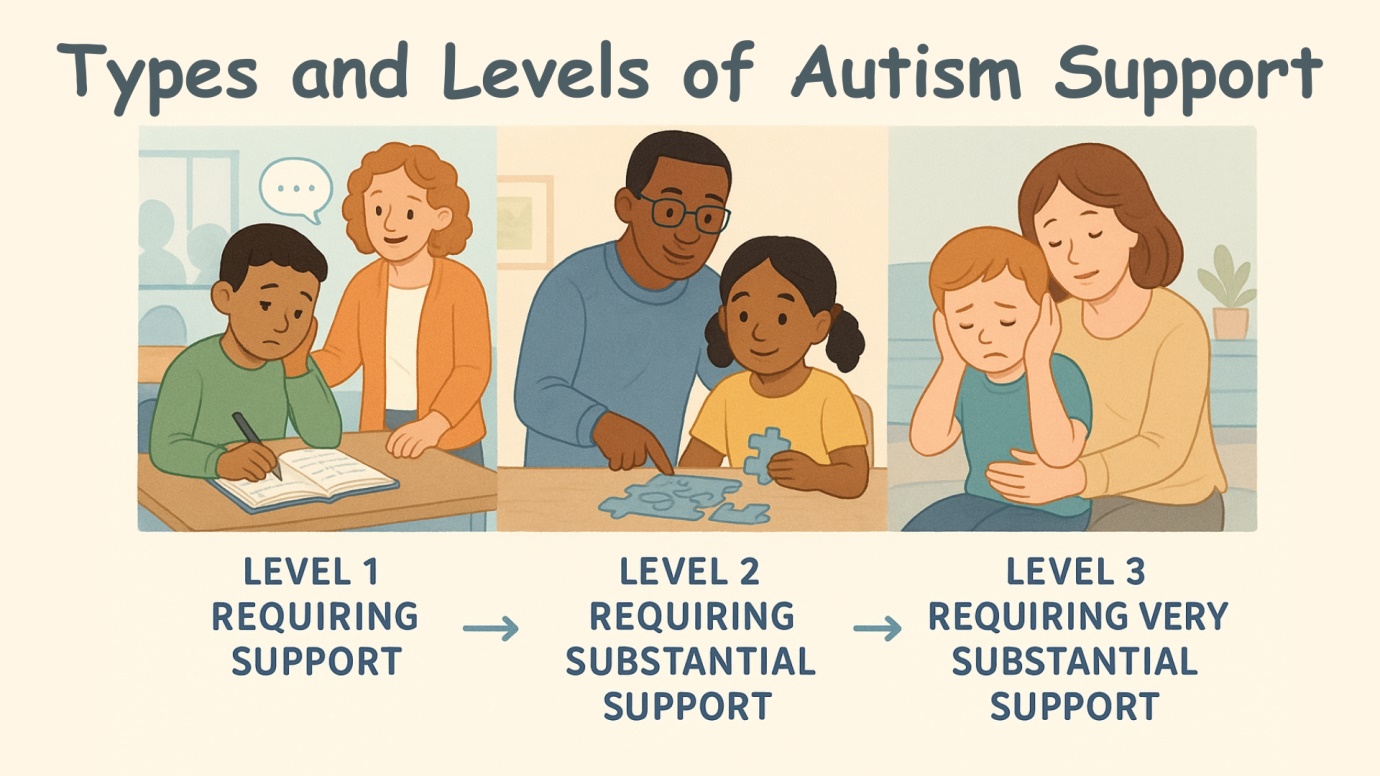
Levels of Support Needs
Clinically, professionals now describe types of ASD based on three levels, which help guide support and therapy plans:
Level 1: Requiring Support
- Often referred to in everyday language as high functioning autism spectrum disorder.
- Individuals may have mild social difficulties and repetitive behaviors but can often live independently with some support.
- May struggle with social cues or flexible thinking but can usually adapt in structured environments.
Level 2: Requiring Substantial Support
- Falls between high and severe support needs.
- People may have more noticeable difficulties with verbal and nonverbal communication.
- Rigid routines and repetitive behaviors are more obvious.
- Daily support may be needed at school, work, or home to manage tasks.
Level 3: Requiring Very Substantial Support
- This is sometimes referred to as severe autism spectrum disorder.
- Individuals often have significant challenges with communication and may be nonverbal.
- High levels of repetitive behaviors and restricted interests.
- They may need continuous, intensive support for daily living, safety, and basic needs.
Other Common Descriptions
While these levels are the clinical standard, many people still hear older or informal labels, such as:
High functioning autism spectrum disorder:
Generally used for people at Level 1.
Low functioning autism spectrum disorder:
An outdated term sometimes used for those with higher support needs, but many experts now avoid these labels because they can be misleading or stigmatizing.
Autism spectrum pervasive developmental disorder:
This term covered a range of conditions before the modern ASD classification was adopted.
The most important thing to remember is that each individual suffering from Autism Spectrum Disorder is unique. Labels like the types of ASD are only meant to help families and professionals create the right support plan — they do not define a person’s potential. Whether someone has high functioning autism spectrum disorder or severe autism spectrum disorder, understanding and acceptance are what help them reach their best possible quality of life.
Therapies and Treatments for Autism Spectrum Disorder
When it comes to Autism Spectrum Disorder, there is no one-size-fits-all cure — but there are many proven ways to help people thrive. A well-planned autism spectrum disorder treatment can make a huge difference by supporting communication, learning, daily living, and emotional well-being.
Modern management of autism spectrum disorder focuses on individualized care. What works for one person may be different for another, but the goal is always the same: to help the person with ASD reach their full potential.
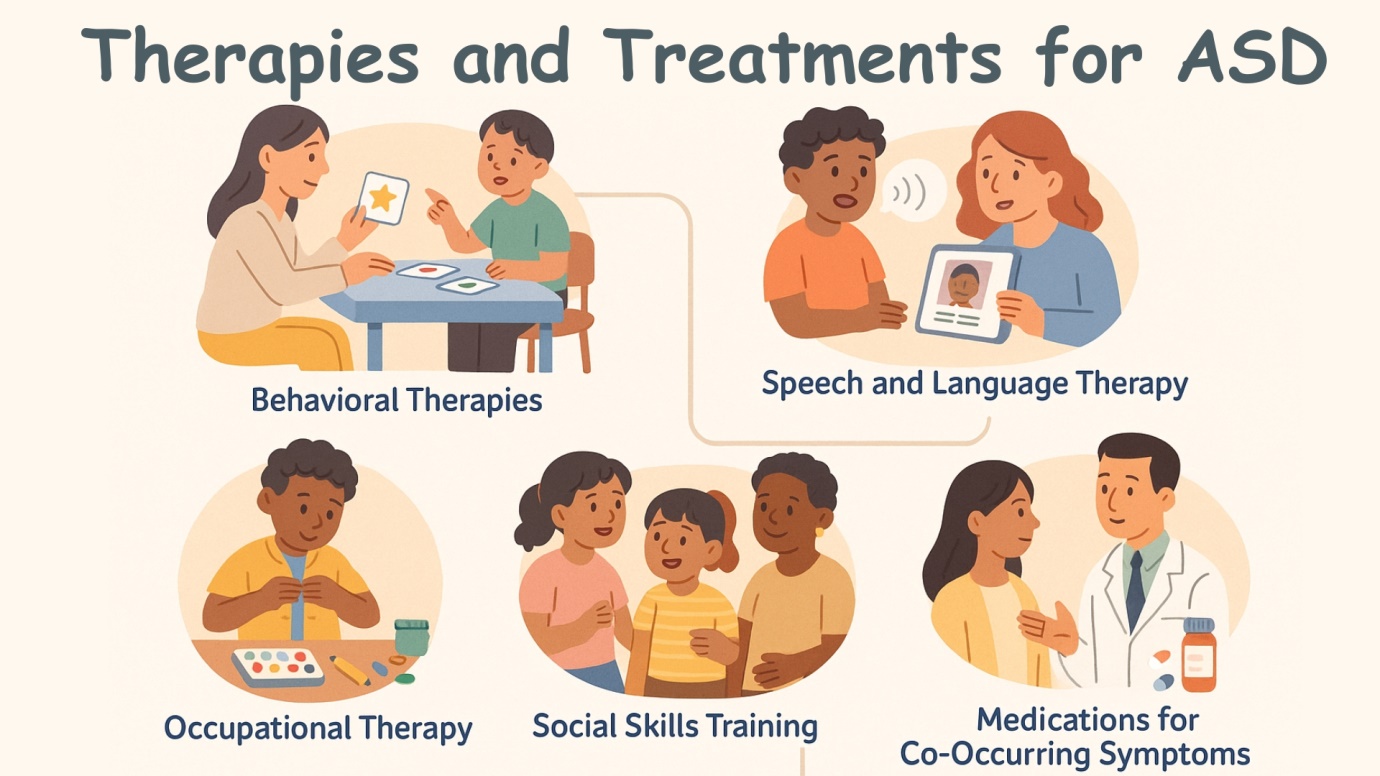
Behavioral Therapies
One of the most well-known approaches in therapy for autism spectrum disorder is ABA Therapy (Applied Behavior Analysis). This method uses positive reinforcement to teach new skills and reduce challenging behaviors.
Some families also choose the Early Start Denver Model (ESDM), which combines ABA principles with play-based learning for young children.
Both methods are widely respected and form a key part of effective autism spectrum disorder treatment plans.
Speech and Language Therapy
Communication is often a challenge for individuals with ASD, so speech and language therapy plays a vital role in the management of autism spectrum disorder.
This type of therapy for autism spectrum disorder can help children and adults:
- Develop spoken language if they’re nonverbal or minimally verbal.
- Improve understanding of verbal and nonverbal communication.
- Use alternative communication methods like picture cards or devices if needed.
Occupational Therapy
Another important element of autism spectrum disorder treatment is occupational therapy (OT). OT focuses on building everyday skills that make life more independent and comfortable.
Examples of OT goals include:
- Improving motor skills (like writing or using utensils).
- Developing self-care routines (like dressing or brushing teeth).
- Helping individuals manage sensory sensitivities.
A good occupational therapy plan is an essential part of the overall management of autism spectrum disorder.
Social Skills Training
Learning how to interact with others is a big part of therapy for autism spectrum disorder. Social skills training helps children and adults:
- Read social cues and body language.
- Practice conversation skills.
- Build and maintain friendships.
This approach works well alongside other autism spectrum disorder treatments, creating a well-rounded support system.
Medications for Co-Occurring Symptoms
There is no medicine for autism spectrum disorder that “cures” core traits, but medication can help manage co-occurring challenges like anxiety, aggression, or hyperactivity.
Some examples of medication for autism spectrum disorder may include:
- Antipsychotics like Risperidone for severe irritability.
- Stimulants for ADHD-like symptoms.
- Anti-anxiety medicines to help manage stress.
Always consult a specialist before starting any medicine for autism spectrum disorder to ensure safety and effectiveness.
The right autism spectrum disorder treatment plan combines therapies, family support, and sometimes medication for autism spectrum disorder to help each individual live their best life. With early intervention and a tailored approach, the management of autism spectrum disorder becomes a journey of growth, self-confidence, and inclusion.
Diet and Nutrition in ASD
Nutrition plays a bigger role than many people realize when it comes to supporting individuals with Autism Spectrum Disorder. While there is no specific “cure” diet for ASD, a thoughtful, balanced approach to food can help manage some common challenges and support overall well-being.
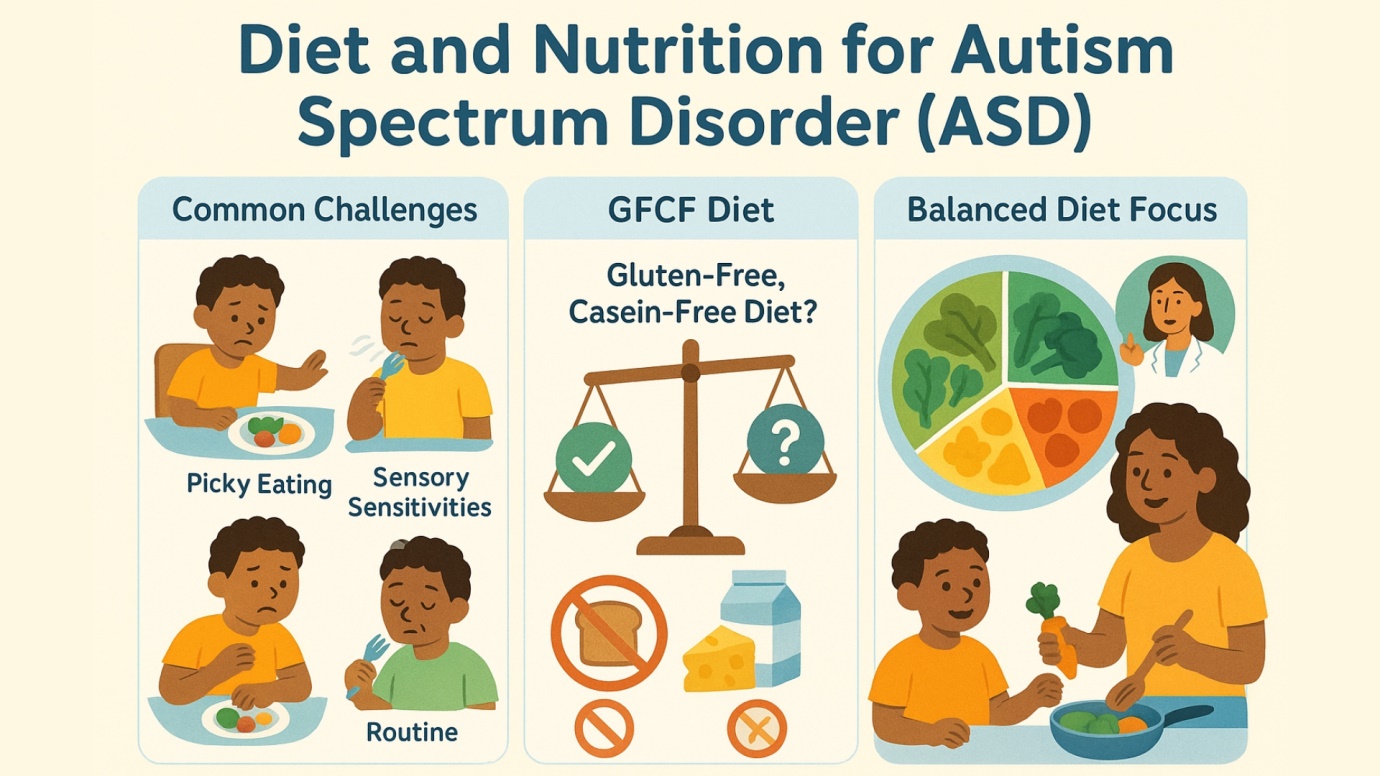
Common Nutrition Challenges
Many children & adults with Autism Spectrum Disorder face unique eating issues. Some of the most common include:
Picky eating:
It’s not unusual for someone with ASD to have a very limited range of preferred foods.
Food aversions:
Certain textures, colors, or smells can be overwhelming due to sensory sensitivities linked to ASD.
Routine-based eating:
Some individuals may insist on eating same foods every day, which can lead to nutritional gaps.
Addressing these eating habits is an important part of supporting someone with Autism Spectrum Disorder in everyday life.
GFCF Diet — Is It Evidence-Based?
You may have heard of the Gluten-Free, Casein-Free (GFCF) diet for people with ASD. Many families explore this option, hoping it might reduce Autism Spectrum Disorder symptoms.
However, scientific studies on the GFCF diet show mixed results. While some parents report improvements in behavior or digestion, there is no strong, universal evidence that a GFCF diet works for everyone with ASD. For some, removing gluten and dairy can help manage gut issues or allergies, but for others, it may have little effect. It’s always best to talk with a qualified nutrition professional before making big dietary changes.
Role of a Balanced Diet
A well-balanced diet is crucial for anyone with Autism Spectrum Disorder. It helps:
- Fill nutritional gaps caused by picky eating.
- Support healthy growth and brain development.
- Boost energy and overall mood.
- Prevent other health issues, such as vitamin deficiencies or digestive problems.
Whether or not a family chooses a specialized diet, focusing on variety, whole foods, and proper nutrients is the foundation of good health for those with ASD.
How Moto Nutrition Supports Families
At Moto Nutrition, we understand that every child or adult with Autism Spectrum Disorder has unique needs. That’s why we create personalized nutrition plans that respect individual preferences, sensitivities, and family routines.
Our experts guide families through:
- Safe diet modifications for ASD.
- Managing picky eating habits in a positive way.
- Ensuring balanced intake despite food selectivity.
- Tracking growth and health markers for peace of mind.
While diet alone won’t “treat” Autism Spectrum Disorder, smart nutrition choices can make life healthier and more comfortable for people with ASD. With professional guidance and support from trusted partners like Moto Nutrition, families can feel confident they’re giving their loved ones the best start possible.
Precautions and Daily Support for Autism Spectrum Disorder
Living with Autism Spectrum Disorder means every day can bring unique experiences and challenges. While there is no single roadmap for daily life with ASD, practical precautions and supportive routines help families create safe, nurturing environments that honor each individual’s needs. A thoughtful approach also plays a vital role in the long-term autism spectrum disorder prognosis — promoting better outcomes and quality of life.
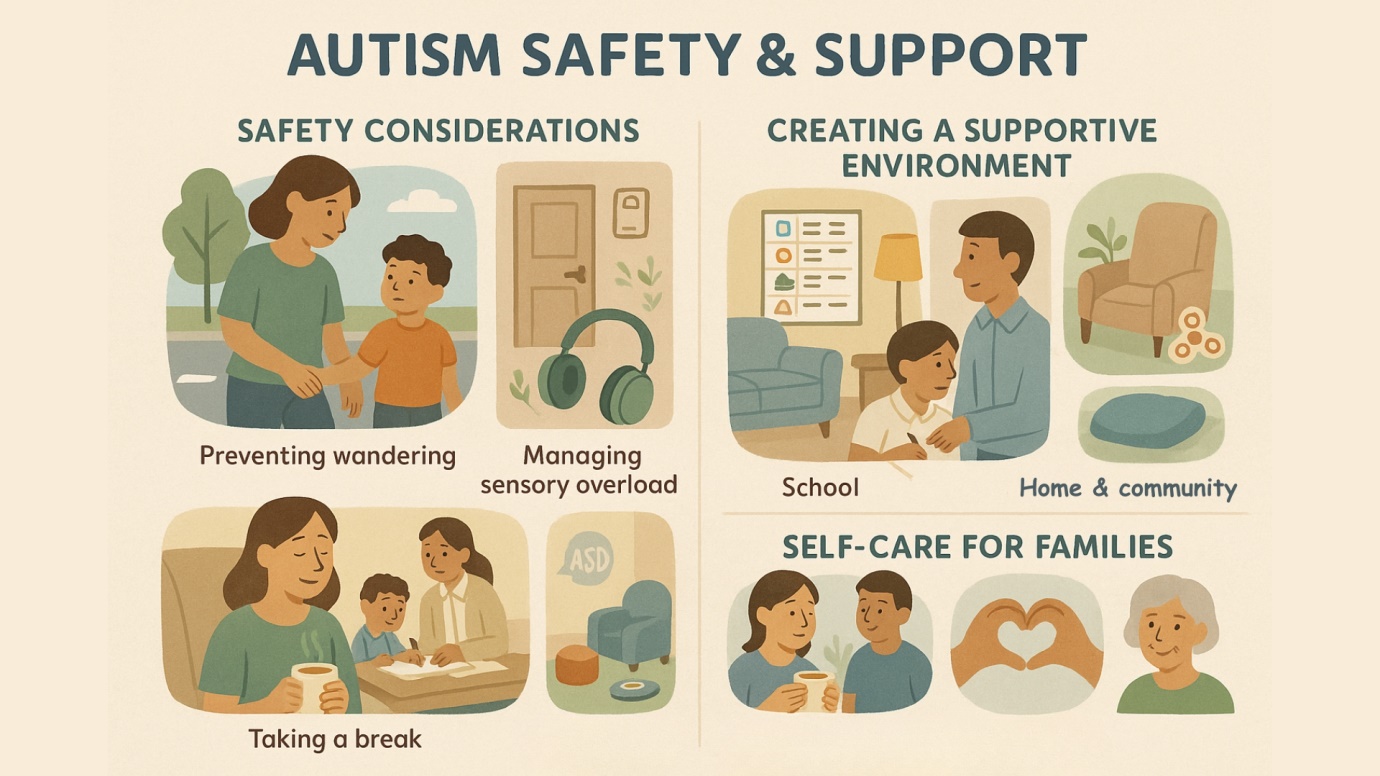
Safety Considerations
Safety is often a top concern for families managing Autism Spectrum Disorder, especially when individuals have difficulties with awareness or communication.
Some key risks include:
Wandering:
Many children with ASD have a tendency to wander or “bolt” from safe spaces, which can be dangerous near roads, water, or crowds.
Sensory overload:
Loud noises, bright lights, or crowded places can be overwhelming due to unique sensory processing linked to Autism Spectrum Disorder. Preparing with noise-cancelling headphones, fidget toys, or quiet spaces helps manage this.
Understanding danger:
Because some people with ASD may have challenges with the theory of mind autism spectrum disorder (understanding others’ perspectives) or cause-and-effect thinking, they may not recognize certain hazards. Extra precautions at home — like door alarms or locked cabinets — can make a big difference.
Creating a Supportive Environment
Providing daily support for someone with Autism Spectrum Disorder is about making spaces feel safe, predictable, and encouraging.
At home:
Keep routines consistent, use visual schedules, and adapt spaces for sensory comfort.
At school:
Collaborate with teachers to ensure individualized learning plans, sensory breaks, and social skills training.
In the community:
Help others understand that ASD is not a misbehavior — it’s a different way of experiencing the world.
Self-Care for Families
Supporting someone with Autism Spectrum Disorder is rewarding but can also be exhausting. Caregivers and siblings need care too!
- Take breaks when needed.
- Reach out for respite care if available.
- Practice self-care routines that keep stress levels in check.
These efforts help families stay strong and positively impact the autism spectrum disorder prognosis.
Daily support and precautions shape the future for individuals with ASD. By focusing on safety, understanding unique needs like theory of mind autism spectrum disorder, and acknowledging when autism spectrum disorder and intellectual disability overlap, families can create a caring environment that supports positive development and long-term well-being. Remember: no two journeys are the same — but no one has to walk this path alone.
FAQs
Q1. What is ASD?
- A. ASD stands for Autism Spectrum Disorder, which is a developmental condition that affects how people communicate, interact socially, and process the world around them. The autism spectrum disorder meaning is that it’s a spectrum — no two people experience it the same way.
Q2. What are common autism spectrum disorder symptoms?
- A. Common autism spectrum disorder symptoms include challenges with social interaction, communication difficulties, repetitive behaviors, and sensory sensitivities. ASD symptoms can vary greatly from person to person.
Q3. How early can autism spectrum disorder be diagnosed?
- A. A formal autism spectrum disorder diagnosis can often be made as early as 18–24 months when early signs are clear. However, some people may not get an ASD diagnosis until later childhood or adulthood.
Q4. What are the primary causes of autism spectrum disorder?
- A. The causes of autism spectrum disorder are complex. Genetics play a major role, and some environmental factors may contribute. But there is no single cause that applies to everyone with ASD.
Q5. Is autism spectrum disorder a learning disability?
- A. Not necessarily. While some people with ASD may have intellectual disabilities or learning differences, many do not. Every person’s strengths and challenges are different.
Q6. Can medication for autism spectrum disorder help?
- A. There’s no medicine that “cures” ASD, but medication for autism spectrum disorder can help manage co-occurring issues like anxiety, aggression, or hyperactivity. Always consult a specialist.
Q7. Does diet help manage autism spectrum disorder symptoms?
- A. A balanced diet can support overall health for people with ASD. Some families try special diets, but evidence is mixed. It’s best to talk to a nutrition expert for personalized advice.
Q8. What is high functioning autism spectrum disorder?
- A. High functioning autism spectrum disorder is an informal term used to describe individuals with ASD who need less daily support and have strong verbal or cognitive skills. Clinically, this is usually Level 1.
Q9. Is there a cure for autism spectrum disorder?
- A. No, Autism Spectrum Disorder is not an illness that needs to be “fixed.” With the right support, therapy, and understanding, people with ASD can thrive & live fulfilling lives.
Q10. How does Moto Nutrition help children with ASD?
- A. Moto Nutrition provides customized diet plans for children with ASD, helping families manage picky eating, sensory food issues, and balanced nutrition to support healthy growth.
Conclusion
Living with Autism Spectrum Disorder is not about “fixing” something that is broken — because ASD is not an illness to be cured, but a different and beautiful way of being. The real key to helping people with Autism Spectrum Disorder thrive is understanding, acceptance, and support that respects each individual’s unique strengths and challenges.
Every person with ASD has their own story. Some may need minimal assistance, while others need daily support. But what they all deserve is the same: compassion, respect, and a world that includes everyone — differences and all.
Here are a few ways you can make a difference:
- Share what you’ve learned about Autism Spectrum Disorder with your friends and family.
- Challenge outdated myths and spread real awareness about what ASD truly means.
- Be kind, patient, and open-minded when interacting with someone on the spectrum.
At Moto Nutrition, we believe that every individual with Autism Spectrum Disorder deserves the chance to live a healthy and fulfilling life. That’s why we offer personalized diet and nutrition plans that help families navigate picky eating, sensory food aversions, and special dietary needs. Good nutrition can be one more building block in the bigger picture of supporting well-being for those with ASD.
If you’d like expert guidance for your family’s nutrition journey with Autism Spectrum Disorder, we’re here to help. Explore our specialized services at Moto Nutrition and see how our caring team can make mealtimes healthier, calmer, and happier for your loved one.
Explore our nutrition resources or book a consultation at Moto Nutrition to take your first step toward a healthier, more focused life. For more information on our personalized diet plans and nutritional support, visit our Homepage.
Disclaimer:
This blog is intended for informational purposes only and should not be considered medical advice or a substitute for professional consultation. While diet, therapies, and lifestyle strategies can support and enhance the well-being of individuals with Autism Spectrum Disorder (ASD), they are not a replacement for professional diagnosis or prescribed treatment. Always consult with a qualified healthcare provider, developmental pediatrician, or mental health professional before starting any new therapies, interventions, or dietary changes for ASD. If you or someone you know is experiencing significant challenges related to Autism Spectrum Disorder, we strongly recommend seeking personalized guidance and care from licensed professionals.